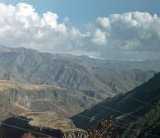 |
QUICK SEARCH
MO PROJECTS:
Africa
Asia/Pacific
Mesoamerica
North America
South America
General Taxonomy
Photo Essays
Training in Latin
America
MO RESEARCH:
Wm. L. Brown Center
Bryology
GIS
Graduate Studies
Research Experiences
for Undergraduates
Imaging Lab
Library
MBG Press
Publications
Climate Change
Catalog Fossil Plants
MO DATABASES:
W³MOST
Image Index
Rare Books
Angiosperm
Phylogeny
Res Botanica
All Databases
INFORMATION:
What's New?
People at MO
Visitor's Guide
Herbarium
Jobs & Fellowships
Symposium
Research Links
Site Map
Search
ORNAMENTAL PLANTS IN THEIR NATURAL HABITATSC. Armenia
Near Garni in the Azat River gorge, dwarf shrubs and subshrubs predominate and many of them are highly attractive. In the spring bulbous plants such as Bellevalia, Muscari, Tulipa and Gagea are abundant. In early summer a few Allium species are showily evident. During their flowering period some perennials and subshrubs are particularly distinctive. Stonecress, Aethionema grandiflorum, has large purple or lilac-pink flowers in elongated racemes. Whitlow-wort, Paronychia kurdica, is a carpet-former, only to 10 cm (3.9") tall and has silvery-grey leaves and small white flowers in dense clusters. An unusual bellflower, Michauxia laevigata, stands 1.5 m (4.9 ft) tall and has numerous white flowers with narrow recurved corolla lobes. Both Jerusalem sage Phlomis orientalis, with stems to 70 cm (27") and Cousinia armena, with stems to 30 cm (11.8"), are recognized by their woolly or tomentose leaves. Bearís breeches Acanthus dioscoridis, a species with very attractive foliage of deep-lobed, dark green, large leaves represents of a Mediterranean genus here, in Armenia. The road from Garni to Gekhard monastery runs along the right bank of the Azat River. In Gekhard, trees and shrubs have persisted near the old monastery, with oak Quercus macranthera, maple Acer trautvetteri and nettle tree Celtis glabrata being the most prevalent. The herbaceous Corydalis angustifolia, C. persica, Erysimum cuspidatum, Primula macrocalyx and Scilla armena flourish in early spring. Campanula choziatowskyi exhibits in summer a splendid masses of blue flowers and is most noticeable on relatively inaccessible rocks but also occurs even on the old stone walls of this ancient monastery. This Campanula is especially impressive when contrasted with the pale yellow flowers of Onosma caucasica. The orchid Dactylorhiza maculata forms handsome compact inflorescences of flowers of mixed colors, white or pink and dark red or lilac. Campanula daralaghezica occurs on rocky slopes, noticeable by its numerous white flowers. A trip from Yerevan to Lake Sevan (Ozero Sevan) also provides convenient access to the flora of the Southern Transcaucasus. Initially, the road runs northward along the valley floor of the Nork gorge, then continues across the Kanaker Plateau. Here, clearly dominant among the semidesert vegetation is the wormwood Artemisia lerchiana. In spring Tulipa biflora and Leopoldia caucasica [=Muscari caucasicum] lie sprinkled among stones, sometimes with Iris iberica subsp. elegantissima as well. Later, in summer, cushion-like plants appear at their best, and species of Acantholimon with white or pink flowers are the most frequent. Near the town of Abovyan, the semidesert is replaced by montane steppe, the dominant elements of which are various Stipa grasses and several tough and prickly-leaved plants, including Centaurea behen, and Echinops pungens. The spiky foliage and inflorescences of these plants are well-suited for dried-flower arrangements and bouquets because the flowers persist for a long time after cutting. Gladiolus atroviolaceus, Iridodictyum reticulatum [=Iris reticulata], and Leopoldia caucasica are undoubtedly the most interesting monocots. Some of the Tsahkunian Range plants, including the great bellflower Campanula latifolia, are popular in local and European gardens. Others, though lovely, are inexplicably overlooked by gardeners. They include Pyrethrum [=Tanacetum] balsamitoides, with its top-branching upright stems and white flower heads in summer and autumn, a Solomon's seal Polygonatum orientale with large white flowers grouped three or more in the leaf axils and the onion relative, Nectaroscordum tripedale, with stems to 80 cm (2.6 ft) and white, purple-striped flowers. Lake Sevan extends over 1,500 square kilometers (579 sq miles) and is located at an elevation of 2,000 m (6,560 ft). The vegetation surrounding the lake is characteristic of montane steppe, except for a small area on the northeastern shore, called "Areguni" that is inhabited by communities of alpine xerophytes, and also with patches of Quercus macranthera. Sevan vegetation includes an abundance of herbaceous ornamentals, including Acantholimon armenum, Anemonastrum fasciculatum, Eremurus spectabilis, Fritillaria caucasica, Hylotelephium caucasicum [=Sedum caucasicum], Iris paradoxa, Jurinea arachnoidea, Sedum oppositifolium, Sempervivum transcaucasicum, Stachys iberica and Tulipa julia. Both the orange globeflower Trollius ranunculinus and the yellow primrose
The alpine flora of the Lesser Caucasus is best represented on Mt. Aragats (Alagez), the the highest in Armenia (4,095 m/13,430 ft). The area between Yerevan and Mt. Aragats provides a wonderful opportunity to see the vertical zonation of the Armenian Highlands. The road first crosses semideserts dominated by Artemisia lerchiana. Near Agarak, the mountain steppe continues, with small areas covered by deciduous shrubs called in Russian "shibliak" and "islands" of dry thin forest. Christís thorn Paliurus spina-christi, Rhamnus pallasii and Ulmus minor [=U. carpinifolia] grow here. The steppe is colonized by various grasses and herbs such as Botriochloa ischaemum, Galium verum, Lotus caucasicus and Scabiosa micrantha. Around the town of Biurakan, Pyrus salicifolia, Rhamnus and Crataegus species can be added. Forest of Quercus macranthera prevail near the fortress of Amberd, with a diverse herb layer growing beneath its tall canopy. The steppe vegetation is seen mainly above the altitudinal limit of montane forests at 2,500 m (8,202 ft). The alpine belt, beginning at 2,700 m (8,858 ft), usually exhibits a number of ornamental plants. Flat and moist areas are covered by Cirsium esculentum, Gagea anisanthos, Gentiana dshimilensis and Ranunculus aragazi. More open and drier terrain is inhabited by the large-leaved rosettes of Chamaesciadium acaule, the small-leaved but large-flowered Campanula tridentata, and the snug cushions of Draba bruniifolia, Minuartia oreina, Sedum tenellum. On the upper alpine slopes are seen plant carpets of Campanula tridentata, Primula algida and Veronica gentianoides. |
|||
| ORNAMENTAL PLANTS FROM RUSSIA |
© 1995-2025 Missouri Botanical Garden, All Rights Reserved
4344 Shaw Blvd.
St. Louis, MO 63110
(314) 577-5100
Technical Support


